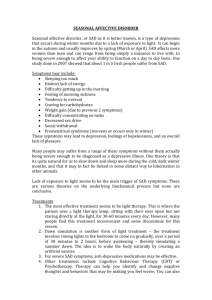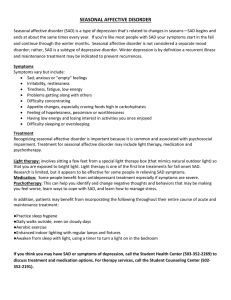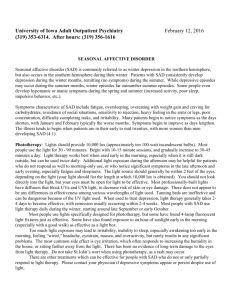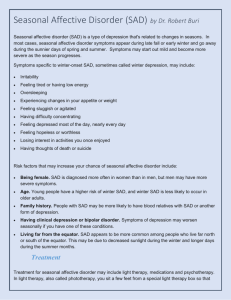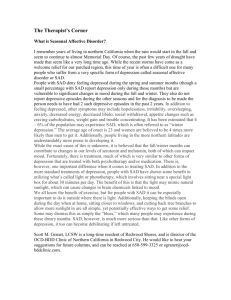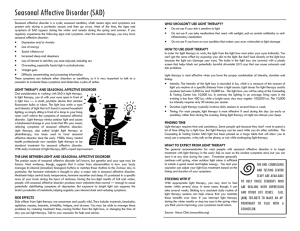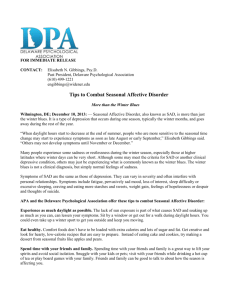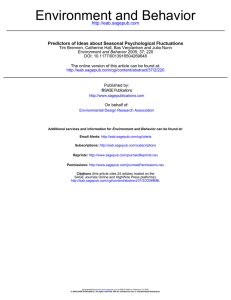Seasonal Affective Disorder (SAD)
advertisement
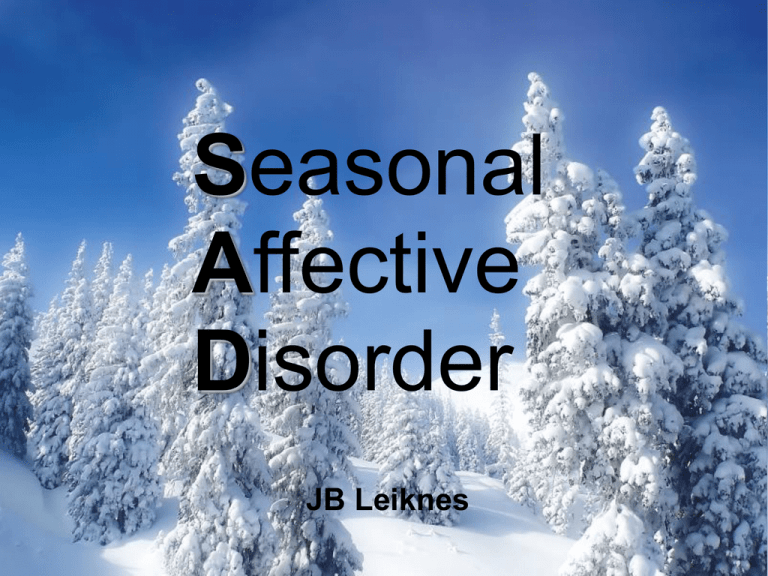
Seasonal Affective Disorder JB Leiknes Seasonal Affective Disorder Mood disorder People who are normally happy experience depressive symptoms during winter months “Winter-blues” or “winter depression” More prevalent in nordic countries First described by scholar Jordanes in the 6th century in his book Getica1 Most prevalent during winter months but can occur during other seasons [Reverse Seasonal Affective Disorder] Classification of SAD In order to qualify as SAD a diagnosis must meet 4 criteria2: Depressive periods at a particular time of year Relapse into depression or mania/hypomania at a particular time of year Pattern of depression lasting two or more years with no nonseasonal major depressive episodes during the same period The instances of depression following a seasonal pattern must outnumber other instances of depression throughout patient's life Etiology Believed to be light-related Serotonin polymorphisms4 Evidence: effectiveness of light-therapy3 Association between SAD and the shorter allele of the serotonin transporter promoter repeat length polymorphism (5-HTTLPR) Mutation in the gene expressing melanopsin Photopigment found in retina, participates in circadian rhythm Treatment Primarily concerning winter-based SAD Light therapy Bright light therapy/dawn simulation5 Medication Timed administration of the hormone melatonin Main theory behind treatment is adjustment of circadian rhythm via use of light or hormones/medicaments to mimic or induce the body's own mechanisms of circadian rhythm Cultural Impact Light cafés Commercially available bright-lights Sources 1 – [Wikipedia] Jordanes' Getica – http://en.wikipedia.org/wiki/Getica_(Jordanes) 2 – [Mayo Clinic] Depression - Seasonal Affective Disorder (SAD) – http://www.mayoclinic.com/health/seasonal-affective-disorder/DS00195/DSECTION=symptoms 3 – [American Journal of Psychiatry] The Can-SAD Study: A Randomized Controlled Trial of the Effectiveness of Light Therapy and Fluoxetine in Patients With Winter Seasonal Affective Disorder – http://ajp.psychiatryonline.org/cgi/content/abstract/163/5/805 4 – [Neurobiology of Disease] Seasonal Affective Disorder and Serotonin-Related Polymorphisms – http://www.sciencedirect.com/science?_ob=ArticleURL&_udi=B6WNK457VFDV13&_user=10&_rdoc=1&_fmt=&_orig=search&_sort=d&view=c&_acct=C000050221&_version= 1&_urlVersion=0&_userid=10&md5=cdf40c7c01f51290364ab7709dbeacf4 5 – [Biological Psychiatry] Dawn simulation and bright light in the treatment of SAD: a controlled study – http://www.sciencedirect.com/science?_ob=ArticleURL&_udi=B6T4S43RJ7CF8&_coverDate=08%2F01%2F2001&_alid=509264218&_rdoc=1&_fmt=&_orig=search&_qd=1&_ cdi=4982&_sort=d&view=c&_acct=C000022721&_version=1&_urlVersion=0&_userid=489256& md5=c2dc9bcba4a21f35f9482ab0fd10cd1a
